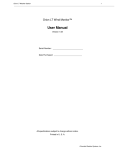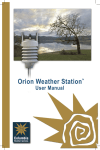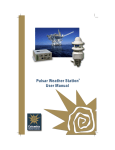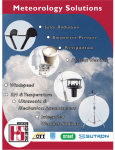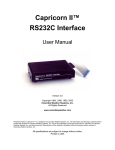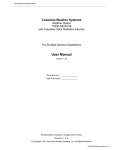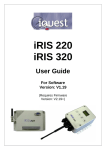Download Orion Car Audio 420 User's Manual
Transcript
Orion 420 Weather Station 1 ________________________________________________________________________________________________________ Orion 420 Weather Station™ User Manual Version 1.04 All specifications subject to change without notice. Printed in U. S. A. Columbia Weather Systems, Inc. 2 Orion 420 Weather Station ________________________________________________________________________________________________________ © Copyright 2005, 2006, 2007, 2008 Columbia Weather Systems, Inc. All Rights Reserved. Proprietary Notice: Orion, Orion 420, Orion 510, Capricorn 2000, Capricorn 2000MP and Capricorn 2000EX are trademarks of Columbia Weather Systems, Inc. The information and drawings contained herein are the sole property of Columbia Weather Systems, Inc. Use of this publication is reserved exclusively for customers of Columbia Weather Systems, Inc. and their personnel. Reproduction of this material is forbidden without the express written consent of Columbia Weather Systems, Inc. Parts of the Orion 420 Weather Station™ user manual were adapted from the Weather Transmitter WXT510 User’s Guide with permission from Vaisala Oyj. WINDCAP®, RAINCAP®, HUMICAP®, BAROCAP® and THERMOCAP® are registered trademarks of Vaisala. Orion 420 Weather Station 3 ________________________________________________________________________________________________________ Welcome! Welcome to the Columbia Weather Systems family of users and congratulations on your purchase of the Orion Weather Station. The Orion 420 Weather Station is quite easy to install and you may be tempted to skip the installation procedure or other portions of this manual. We recommend that you resist that urge. A thorough knowledge of these installation and calibration procedures will greatly increase the usefulness and the accuracy of your instrument. In particular, a proper installation will help prevent problems with both operation and maintenance. Please read this manual completely prior to installation. Columbia Weather Systems, Inc. 4 Orion 420 Weather Station ________________________________________________________________________________________________________ Orion 420 Weather Station 5 ________________________________________________________________________________________________________ Important Notice: Shipping Damage BEFORE YOU READ ANY FURTHER, please inspect all system components for obvious shipping damage. The Orion 420 is a high precision instrument and can be damaged by rough handling. Your unit was packaged to minimize the possibility of damage in transit. Therefore, we recommend that you save the shipping container for any future shipment of your Orion unit. In the event your order arrives in damaged condition, it is important that the following steps be taken immediately. The title transfers automatically to you, the customer, once the material is entrusted to the transport company. NOTE: DO NOT RETURN THE INSTRUMENT TO COLUMBIA WEATHER SYSTEMS until the following steps are completed. Failure to follow this request will jeopardize your claim. 1. Open the container and inspect the contents. Do not throw away the container or any damaged parts. Try to keep items in the same condition as originally received. 2. Notify the transport company immediately in writing, preferably by facsimile, about the shipping damage. 3. Wait for the transport company’s representative to inspect the shipment personally. 4. After inspection, request permission from Columbia Weather Systems for return of the damaged instrument by calling the Service Department, (503) 629-0887. 5. Return approved items to us at the following address: Columbia Weather Systems, Inc. 2240 NE Griffin Oaks Street, Suite 100 Hillsboro, OR 97124 6. After return authorization is issued and we receive the instrument, an estimate of the cost of repair will be sent to you for submittal to the transport company as a claim. ESD Protection Electrostatic Discharge (ESD) can cause immediate or latent damage to electronic circuits. The Orion 420 is adequately protected against ESD for its intended use. However, it is possible to damage the product by delivering electrostatic discharges when touching, removing, or inserting any objects inside the equipment housing. To make sure you are not delivering high static voltages yourself: 1. Handle ESD sensitive components on a properly grounded and protected ESD workbench. When this is not possible, ground yourself with a wrist strap and a resistive connection cord to the equipment chassis before touching the boards. When neither of the above is possible, at least touch a conductive part of the equipment chassis with your other hand before touching the boards. 2. Always hold the boards by the edges and avoid touching the component contacts. Columbia Weather Systems, Inc. 6 Orion 420 Weather Station ________________________________________________________________________________________________________ Orion 420 Weather Station 7 ________________________________________________________________________________________________________ Table of Contents WELCOME! .................................................................................................. 3 IMPORTANT NOTICE: SHIPPING DAMAGE ....................................... 5 ESD PROTECTION................................................................................................................. 5 SECTION 1: INTRODUCTION .................................................................. 9 THE ORION 420 WEATHER STATION .................................................................................... 9 Features:........................................................................................................................ 10 SPECIFICATIONS ................................................................................................................. 10 Temperature .................................................................................................................. 10 Barometric Pressure...................................................................................................... 10 Wind Speed .................................................................................................................... 10 Wind Direction .............................................................................................................. 10 Relative Humidity .......................................................................................................... 10 Rainfall .......................................................................................................................... 11 Input Voltage ................................................................................................................. 11 Serial to Analog Converters .......................................................................................... 11 CURRENT CONSUMPTION: 30 MA TO 110 MAPRINCIPLES OF MEASUREMENTS .................. 11 PRINCIPLES OF MEASUREMENTS ........................................................................................ 12 Wind Measurement ........................................................................................................ 12 Barometric Pressure, Temperature, and Relative Humidity (PTU) Module ................. 12 Rainfall Measurement.................................................................................................... 13 SECTION 2: PHYSICAL DESCRIPTION............................................... 15 ORION SENSOR TRANSMITTER ........................................................................................... 15 Sensor Transmitter Components.................................................................................... 15 Mounting Adapter.......................................................................................................... 16 Internal Terminal Block................................................................................................. 16 ORION 420 WEATHERPROOF ENCLOSURE .......................................................................... 18 SECTION 3: INSTALLATION ................................................................. 19 WEATHER STATION SYSTEM CONFIGURATIONS ................................................................. 19 INSTALLATION OVERVIEW ................................................................................................. 20 TOOLS NEEDED .................................................................................................................. 20 MATERIALS NEEDED .......................................................................................................... 20 UNPACKING THE UNIT ........................................................................................................ 20 Installing the Orion Sensor Transmitter ........................................................................ 22 Site Selection: ................................................................................................................ 22 Installing the Mounting Adapter.................................................................................... 22 North Alignment ............................................................................................................ 22 Installing the Mast ......................................................................................................... 23 Location......................................................................................................................... 23 Mounting Method .......................................................................................................... 23 Routing Cable................................................................................................................ 24 Connecting the Sensor Transmitter to the Orion Weatherproof Enclosure................... 24 Connecting the 420 Weatherproof Enclosure to the PLC.............................................. 25 SECTION 4: OPTIONAL SENSOR MOUNTING HARDWARE......... 27 ROOF MOUNTING ............................................................................................................... 27 WALL MOUNTING .............................................................................................................. 28 TRIPOD ............................................................................................................................... 30 Specifications................................................................................................................. 30 SECTION 5: OPERATION ........................................................................ 33 SECTION 6: MAINTENANCE ................................................................. 35 Columbia Weather Systems, Inc. 8 Orion 420 Weather Station ________________________________________________________________________________________________________ CLEANING .......................................................................................................................... 35 REPLACING THE PTU MODULE .......................................................................................... 35 FACTORY CALIBRATION AND REPAIR SERVICE .................................................................. 35 SECTION 7: TROUBLESHOOTING....................................................... 37 SECTION 8: USER SUPPORT INFORMATION ................................... 39 LIMITED WARRANTY ......................................................................................................... 39 EXCLUSIONS................................................................................................................ 39 RETURN FOR REPAIR PROCEDURE ...................................................................................... 39 Orion 420 Weather Station 9 ________________________________________________________________________________________________________ SECTION 1: INTRODUCTION The Orion 420 Weather Station Utilizing cutting-edged ultrasonic technology at an amazingly affordable price, the Orion 420 Weather Station is the newest product in our family of innovative weather monitoring systems. Orion provides ultrasonic wind direction and speed measurements, a highly-accurate impact rain sensor, capacitive relative humidity, temperature and barometric pressure readings – all in a single sensor module. High accuracy and fine resolution make this new system ideal for precision weather monitoring. Orion provides 4-20 mA current output for 8 weather parameters. Columbia Weather Systems, Inc. 10 Orion 420 Weather Station ________________________________________________________________________________________________________ Features: • Six most essential weather parameters measured in one instrument • Accurate and stable measurement • Ultrasonic wind sensor and impact precipitation sensor • No moving parts means virtually no maintenance • Low power consumption improves reliability and longevity • Compact and lightweight with a single cable for quick installation Specifications Temperature Range: -60 to 140°F (-52 to +60°C) Accuracy: ±-0.5°F (±0.3°C) at 68°F (+20°C) Resolution: 0.1°F (0.1°C) Units Available: °F, °C Barometric Pressure Range: 17.50 to 32.50 InHg (600 to 1100 mbar) Accuracy: ±0.015 InHg (0.5 mbar) at +32 to 86°F (0 to 30°C) ±0.03 InHg (1 mbar) at -60 to 140°F (-52 to 60°C) Resolution: 0.01 InHg (0.1 mbar) Units Available: Kpa, mbar, InHg Wind Speed Range: 0 - 115 mph (0 - 60 m/s) Accuracy: ±0.7 mph (±0.3 m/s) Resolution: 1 mph (1 m/s) Units Available: knots, mph, km/hr, m/s Wind Direction Azimuth: 0 - 360° Accuracy: ±2° Resolution: 1° Relative Humidity Range: 0 - 100%RH Accuracy: ±3%RH (0-90%), ±5% (90-100%) Resolution: 1%RH Units Available: %RH Orion 420 Weather Station 11 ________________________________________________________________________________________________________ Rainfall Range: cumulative Collection Area: 60 cm2 Accuracy: ±5% (spatial variations may exist) Resolution 0.01 in. (0.254mm ) Units Available: mm, inches Input Voltage The Orion 420 is powered with an internal switching power supply Input: 120/240 VAC, 60 HZ Serial to Analog Converters Analog Range: 4-20 mA Accuracy at 25°C: 0.1% of range Operating range: 0 – 22mA typ Maximum load: 600 ohms Output reaction time: 0 – 40 ms DA Conversion: 12 bits (resolution 4096) Current Consumption: 30 mA to 110 mA Columbia Weather Systems, Inc. 12 Orion 420 Weather Station ________________________________________________________________________________________________________ Principles of Measurements Wind Measurement Both wind speed and direction are measured using advanced ultrasonic technology. The sensor utilizes ultrasound to determine horizontal wind readings. The array of three equally-spaced ultrasonic transducers on a horizontal plane is an ideal design that ensures accurate wind measurement from all directions, without blind angles or corrupted readings. The wind sensor has no moving parts, which makes it virtually maintenance free. Wind speed and wind directions are determined by measuring the time it takes the ultrasound to travel from each transducer to the other two. The wind sensor measures the transit time (in both directions) along the three paths established by the array of transducers. This transit time depends on the wind speed along the ultrasonic path. For zero wind speed, both the forward and reverse transit times are the same. With wind along the sound path, the up-wind direction transit time increases and the down-wind transit time decreases. The wind speed is calculated from the measured transit times using the following formula: Vw = 0.5 x L x (1/ tf – 1/tr where: Vw = Wind speed L = Distance between the two transducers tf = Transit time in forward direction tr = Transit time in reverse direction Measuring the six transit times allows Vw to be computed for each of the three ultrasonic paths. The computed wind speeds are independent of altitude, temperature and humidity, which are cancelled out when the transit times are measured in both directions, although the individual transit times depend on these parameters. Using Vw values of two array paths is enough to compute wind speed and wind direction. A signal processing technique is used so that wind speed and wind direction are calculated from the two array paths of best quality. The wind speed is represented as a scalar speed in selected units (m/s, kt, mph, km/h). The wind direction is expressed in degrees (°). The wind direction reported indicates the direction that the wind comes from. North is represented as 0°, east as 90°, south as 180°, and west as 270°. The wind direction is not calculated when the wind speed drops below 0.05 m/s. In this case, the last calculated direction output remains until the wind speed increases again to the level of 0.05 m/s. The average values of wind speed and direction are calculated as a scalar average of all samples over the selected averaging time (1 ... 900 s). The sample count is based on a 4 Hz sampling rate. The minimum and maximum values of wind speed and direction represent the corresponding extremes during the averaging time. Barometric Pressure, Temperature, and Relative Humidity (PTU) Module Barometric pressure, temperature, and humidity measurements are combined in an advanced sensor module (PTU) utilizing a capacitive measurement method for each parameter. The PTU module contains separate sensors for pressure, temperature, and humidity measurement. The measurement principle of the pressure, temperature, and humidity sensors is based on an advanced RC oscillator and two reference capacitors against which the capacitance of the sensors is continuously measured. The microprocessor of the transmitter performs compensation for the temperature dependency of the pressure and humidity sensors. Barometric pressure is measured using a capacitive silicon BAROCAP® sensor. The sensor has minimal hysteresis and excellent repeatability, as well as outstanding temperature and long-term stability. Temperature is measured with a capacitive ceramic THERMOCAP® sensor. Orion 420 Weather Station 13 ________________________________________________________________________________________________________ Relative humidity measurement is based on a capacitive thin film polymer HUMICAP®180 sensor. The sensor is highly accurate with negligible hysteresis and excellent long-term stability in a wide range of environments. Radiation Shield: This module is mounted in a specially-designed radiation shield which protects the sensors from both scattered and direct sunlight and precipitation. The composite material in the plates offers excellent thermal characteristics and UV stabilized construction. The white outer surface reflects radiation, while the black inside absorbs accumulated heat. The internal sensor module is easily replaceable and readily available as a spare component. To order a replacement module, please use catalog no. 9581. Rainfall Measurement Rainfall is measured with an impact sensor, which detects the size and impact of individual rain drops. The signals resulting from the impacts are proportional to the volume of the drops. Hence, the signal from each drop can be converted directly to the accumulated rainfall. This measurement method eliminates flooding and clogging, as well as wetting and evaporation losses. The sensor transmitter uses RAINCAP® sensor 2 technology in precipitation measurement. The precipitation sensor is comprised of a steel cover and a piezoelectric sensor mounted on the bottom surface of the cover. The precipitation sensor detects the impact of individual raindrops. The signals from the impact are proportional to the volume of the drops. Advanced noise filtering technique is used to filter out signals originating from other sources than raindrops. The measured parameter is accumulated rainfall. Detection of each individual drop enables computing of rain amount with high resolution. Columbia Weather Systems, Inc. 14 Orion 420 Weather Station ________________________________________________________________________________________________________ Orion 420 Weather Station 15 ________________________________________________________________________________________________________ SECTION 2: PHYSICAL DESCRIPTION Orion Sensor Transmitter The Orion Sensor Transmitter is an all-in-one sensor unit containing ultrasonic wind speed and direction sensor, temperature sensor, relative humidity sensor, barometric pressure sensor and an impact rain sensor. The temperature, relative humidity and barometric pressure sensors are combined in a single module housed in a self-aspirating radiation shield. Sensor Transmitter Components 1: Top of the transmitter 2: Radiation Shield 3: Bottom of the transmitter 4: Screw cover Cut Away View 1: Wind Transducers (3 pcs) 2: Precipitation Sensor 3: Pressure sensor inside the Sensor Module Columbia Weather Systems, Inc. 16 Orion 420 Weather Station ________________________________________________________________________________________________________ 4: Humidity and temperature sensor inside the Sensor Module Bottom of the Transmitter 1: Alignment direction sign 2: Service port 3: Water tight cable gland 4: Unused cable gland, covered Mounting Adapter To facilitate easy installation and north alignment, the Orion 510 Sensor Transmitter comes standard with a mounting adapter. The mounting adapter is easily connected on the end of the mast and the sensor transmitter simply snaps into it. The north alignment needs to be performed only once. Internal Terminal Block The sensor transmitter is shipped with a one (1) foot cable terminated by an 8-pin connector half. This cable is connected to the sensor transmitter (at the factory) via a terminal block. The Orion sensor transmitter has a standard RS-232 wiring as shown below: Orion 420 Weather Station 17 ________________________________________________________________________________________________________ Terminal Number 3 5 6 19 20 Signal TXRXD SGND VINVIN+ Color Orange Black Green White Red For heated sensor transmitters, terminal 17 (HTG-) is connected to the Blue wire and terminal 18 (HTG+) is connected to the Brown wire. Columbia Weather Systems, Inc. 18 Orion 420 Weather Station ________________________________________________________________________________________________________ Heating (Optional) Heating elements located below the precipitation sensor and inside the wind transducers keeps the precipitation and wind sensors free from snow and ice. A heating temperature sensor (Th) underneath the precipitation sensor controls the heating. Three fixed temperature limits, namely +3 °C, -2 °C, and -4 °C (+37 °F, +38 °F, +25 °F) control the heating power as follows: Th > +3 °C heating is off -2 °C < Th < +3 °C 50% heating power -4 °C < Th < -2 °C 100% heating power Th < -4 °C 50% heating power Orion 420 Weatherproof Enclosure The Orion 420 Weatherproof Enclosure contains the following: 1. AC power supply with +24 VDC output 2. AC power filter and suppressor 3. Two RS-232 to 4-20 mA converters 4. Sensor connection terminal block Orion 420 Weather Station 19 ________________________________________________________________________________________________________ SECTION 3: INSTALLATION Weather Station System Configurations Columbia Weather Systems, Inc. 20 Orion 420 Weather Station ________________________________________________________________________________________________________ Installation Overview Unpacking the Unit Installing Sensor Transmitter Installing the Orion 420 Weatherproof Enclosure Connecting the Sensor Transmitter to the enclosure Connecting the enclosure to the PLC Tools Needed Allen wrench (provided with sensor transmitter) Small straight blade (1/8") Screwdriver Power Drill and 3/8" Wire Cutter Compass Materials Needed (See also Optional Sensor Mounting Hardware.) Black PVC Electrical Tape Plastic Wall Bushings Mast: Height above structure: Minimum 5 ft., recommended 10 ft. For Roof Mount “Cold Patch” Roofing Tar 50' Guy Wire Roof Anchor Mount Guy Ring & Collar (3-4) Eye Bolt Screws For Wall Mount (2) 4" Wall Mount Bracket Assembly. (4) Bracket Mounting Screws Unpacking the Unit The sensor transmitter comes in a custom shipping container. Be careful when removing the device. CAUTION: Beware of damaging any of the wind transducers located at the top of the three antennas. Dropping the device can break or damage the transducers. If the antenna bends or twists, the re-aligning can be difficult or impossible. Unpack the Orion weather station and verify that all parts are included. 1. Standard system includes: Orion Sensor Transmitter 50 ft sensor cable + additional cable length if ordered Orion Weatherproof Enclosure User Manual Inspect all system components for obvious shipping damage (Refer to “Important Notice: Shipping Damage” in case of damage). Orion 420 Weather Station 21 ________________________________________________________________________________________________________ Save the shipping carton and packing material in case the unit needs to be returned to the factory. If the system does not operate or calibrate properly, see Section 6: Maintenance and Section 7: Troubleshooting, for further instructions. Columbia Weather Systems, Inc. 22 Orion 420 Weather Station ________________________________________________________________________________________________________ Installing the Orion Sensor Transmitter Site Selection: Finding a suitable site for the sensor transmitter is important for getting representative ambient measurements. The site should represent the general area of interest. The sensor transmitter should be installed in a location that is free from turbulence caused by nearby objects, such as trees or buildings. WARNING: To protect personnel (and the device), a lightning rod should be installed with the tip at least 40 inches (one meter) above the sensor transmitter. The rod must be properly grounded, compliant with all local applicable safety regulations. Installing the Mounting Adapter NOTE: The sensor transmitter must be installed to an upright, vertical position. 1. Insert the mounting adapter in the transmitter lower side as shown in the diagram above. 2. Turn the adapter firmly until you feel that it has snaped into the locked position. 3. Align the transmitter in such a way that the arrow (at the bottom of the transmitter) points to north (see North Alignment). 4. Tighten the fixing screw to fix the adapter firmly to the mast. North Alignment To help the alignment, there is an arrow and text North on the bottom of the transmitter. The transmitter should be aligned in such a way that this arrow points to the north. Wind direction can be referred either the true north, which uses the earth’s geographic meridians, or to magnetic north, which is read with a magnetic compass. The magnetic declination is the difference in degrees between the true north and magnetic north. Compass Alignment Orion 420 Weather Station 23 ________________________________________________________________________________________________________ 1. If the sensor transmitter is already mounted, loosen the fixing screw on the mounting adapter. 2. Use a compass to determine that the transducer heads are exactly in line with the compass and that the arrow on the bottom of the transmitter points to north. 3. Tighten the fixing screw on the mounting adapter when done. Once the sensor transmitter is aligned to north, the transmitter can be removed from the mounting adapter without loosing the north orientation. Installing the Mast The sensor transmitter measures wind speeds of up to 115 mph (60 m/s). However, unless the mast is properly mounted to withstand such high winds, this capability is useless. Please read these instructions carefully to insure a safe and reliable installation. Mounting the mast and the sensor transmitter should be comparable in scope to installing a TV antenna. There are three acceptable methods for mounting the mast to a roof or building structure: Sloped roof mounting, flat roof mounting or wall mounting. See Optional Sensor Mounting Hardware for more information. Location Do not attach the sensor transmitter to a chimney or a TV or radio transmitting mast or tower. Select a mounting location that will allow the sensor cable to be routed away from TV antenna cables and other data cables to avoid interference. Do not mount sensors close to power lines or telephone lines. For normal roof mounting, the recommended minimum distance from power or telephone lines is 25 ft. (8 m). Use extreme caution when working close to power lines. Never route sensor cables in tall trees. Mounting Method Choose the appropriate mounting method for the installation and obtain the necessary mounting hardware. Refer to Section 4 for information on optional sensor mounting hardware and accessories which are available from the factory. If the mounting hardware is not obtained from the factory, be certain to use metal parts which are plated or galvanized to assure maximum longevity. Secure the mast to the roof, using guy wires with sufficient tensile strength. The Wall Mounting Method should utilize a mast of no more than 5 ft. maximum height, unless it can be secured with guy wires. Columbia Weather Systems, Inc. 24 Orion 420 Weather Station ________________________________________________________________________________________________________ Routing Cable Use plastic tie wraps secure the cable to mast. Be sure that one is used at the mast base. Tighten the tie wraps securely and clip off any excess length with a wire cutter tool. Route the cable back to the weatherproof enclosure. If mounting on a roof, route the sensors through a vent or other opening into an attic or crawl space. Avoid routing the cable near metal windows, metal door frames, metal gutters, or on a metal tower. Any mast or tower should always be properly earth grounded to minimize electrical storm damage. The use of a properly grounded metal mast or tower, however, does not insure protection from electrostatic discharge. These items could become electrically charged resulting in damage to the sensors and/or console. This could damage the system in the event of an electrical storm. Use insulated standoffs (user supplied, see Section 4) when routing cable to help avoid this problem. CAUTION: There may be electric wires in the wall. We recommend that you shut off the electricity in the room(s) where you are drilling. For best results when routing the cable through the exterior wall adjacent to the console: a. drill a 3/8" hole though the wall (1/2" if combined with the temperature sensor cable); b. insert a pair of small plastic wall bushings (available as an option; see Section 4) on either side of the wall (or, insert a wall feed-through tube, also optionally available); and c. thread the cable through the bushings or tube. Make sure that the exposed portion of the sensor cable that is beyond the mast will not be blown about by the wind. Use insulated eye bolt standoffs or other fasteners if necessary. (See Section 4 for information on mounting options) Note: If the standard 50 ft. cable provided with the sensor transmitter is not long enough, it may be extended by splicing on an appropriate length of 22-gauge, stranded, five conductor shielded cable with the same color code. When cutting and splicing, insure good contacts, proper color coding of the terminal leads, and a good seal. (A good solder splice, and water proof insulation are essential; merely twisting the respective wires together is not adequate.) Additional cable (Catalog No. 81545) and a water tight splice kit (Cat. No. 81580) are available from the factory. Once the sensor transmitter has been placed, route the cable back to the weatherproof enclosure. Extra cable may be coiled up out of site. Connecting the Sensor Transmitter to the Orion Weatherproof Enclosure Using a #1 Straight Slot screwdriver, attach the wires from the end of the sensor cable to the terminal block screws as shown below: Orion 420 Weather Station 25 ________________________________________________________________________________________________________ For heated sensor transmitters, connect the brown wire along with the red wire to position 1 and connect the blue wire along with the white and bare to terminal 2. Connecting the 420 Weatherproof Enclosure to the PLC Columbia Weather Systems, Inc. 26 Orion 420 Weather Station ________________________________________________________________________________________________________ Orion 420 Weather Station 27 ________________________________________________________________________________________________________ Section 4: Optional Sensor Mounting Hardware Fiberglass and steel 10-foot masts are available for use with either Roof Mounting Hardware Kit (Cat. No. 88002) or Wall Mounting Kit (Cat. No. 88003). A 10-foot free standing tripod is also available. Roof Mounting The Roof Mounting Kit (Cat. No. 88002) is suitable for both a slanted and flat roof installation. The figure and table below illustrates and describes the individual parts. Items included in the kit are marked with an asterisk (*). Individual parts are also available. Description Mast, 10 ft. (steel or fiberglass) *Universal Mast Mount Lag Screw, Roof Mast Mount 1/4" x 4" (for shake roofs *Lag Screw, Roof Mast Mount 1/4" x 2 1/4" (for comp. roofs) *Guy Ring and Collar *Cable Standoffs, Wood Screw Cable Standoffs, Nail-In (for masonry application) Guy Wire Clamps, 1/8" *Steel Guy Wire, Galvanized *Eye Bolt Wood Screws, 1/4" x 3" Turnbuckles, 6" open x 4" closed *Cable Nail Clips Wall Feed Through Tube *Cable Feed Through Bushings Watertight Rubberized Coating Pkg. Ref Catalog No. 1 1 3 1 2 3 88005 / 88004 88010 88020 4 3 88030 1 4 2 4 5 5 88040 88050 88060 3 50 ft. 4 2 20 1 4 17oz (not shown) 6 7 (not shown) 8 10 10 (not shown) 88070 88080 88090 88100 88110 88130 88140 83500 Columbia Weather Systems, Inc. 28 Orion 420 Weather Station ________________________________________________________________________________________________________ Wall Mounting The figure and table below illustrates and describes the individual parts in the Wall Mounting Kit (Catalog No. 88003). Items included in the kit are marked with an asterisk (*). Individual parts are also available. Description Pkg. Ref Catalog No. Mast, 10 ft. 1 1 88005 *4" Wall Mount 2 9 88120 Lag Screw, 1/4" x 2 1/4" 4 3 88030 *Cable Nail Clips 20 8 88110 Wall Feed Through Tube 1 10 88130 *Cable Feed Through Bushings 4 10 88140 Watertight Rubberized Coating 17oz. (not shown) 83500 Orion 420 Weather Station 29 ________________________________________________________________________________________________________ Columbia Weather Systems, Inc. 30 Orion 420 Weather Station ________________________________________________________________________________________________________ Tripod Tripod Model T-1000 is designed to provide up to 10 feet of stable, secure support for your meteorological sensors. The T-1000 is constructed from welded aluminum and is powder coated for appearance and longevity. The 15-pound tripod can easily support up to 60 pounds of equipment. An optional tie-down kit allows for additional security in high-wind areas. Set up takes less than five minutes. Simply insert the legs into the main body and install the stainless steel retainer pins. Extend the mast to the desired height and insert another retainer pin. Install the guy wires and you’re ready to go! Specifications Capacity: Supports up to 60 lbs. Shipping Weight: 17 lbs Shipping Box Dimensions: 63" x 8" x 8" Tripod Model T-1000, Catalog Number: 88007 Tiedown Kit, Catalog Number: 88008 Orion 420 Weather Station 31 ________________________________________________________________________________________________________ Tripod T-1000 (Catalog No. 88007) Parts List: Item # Description Qty 1 Body/Mast Assembly 1 2 Legs 3 3 Retainer Pins 4 4 Guy Wire Ring with 1 3 Wires and Turnbuckles Optional Tiedown Kit (Catalog No. 88008) Parts List: Item # Description Qty 5 Anchor Screw with Chain 1 6 Spring Clamp 1 7 Retainer Pin 1 Columbia Weather Systems, Inc. 32 Orion 420 Weather Station ________________________________________________________________________________________________________ Orion 420 Weather Station 33 ________________________________________________________________________________________________________ Section 5: Operation The Orion 420 outputs the following 8 parameters in 4-20 mA current signals: Channel 1: Wind Direction Description: Instantaneous wind direction. Range: 0 to 360 degrees Channel 2: Wind Speed Description: Instantaneous wind speed. Range: 0 to 135 mph Channel 3: Temperature Description: Instantaneous temperature. Range: -60 to +140°F Channel 4: Relative Humidity Description: Instantaneous relative humidity. Range: 0 to 100% Channel 5: Barometric Pressure Description: Instantaneous barometric pressure. Range: 17 to 33 inches Hg. Channel 6: Peak Wind Speed Description: Peak wind speed in the last 1 second interval. Range: 0 to 135 mph Channel 7: Rainfall Description: 0.001 inches rain accumulation. The sensor internal counter will reset to zero inches when rainfall accumulation reaches 10.00 inches or when power to the sensor is lost. Range: 0 to 10.00 inches Channel 8: Rain Intensity Description: Instantaneous rain intensity. Running one minute average in 10-second steps. Range: 0 to 8 inches/hour Columbia Weather Systems, Inc. 34 Orion 420 Weather Station ________________________________________________________________________________________________________ Orion 420 Weather Station 35 ________________________________________________________________________________________________________ SECTION 6: MAINTENANCE This chapter contains instructions for the basic maintenance of the sensor transmitter. Cleaning To ensure the accuracy of measurement results, the sensor transmitter should be cleaned when it gets contaminated. Leaves and other such particles should be removed from the precipitation sensor and the transmitter should be cleaned carefully with a soft, lint-free cloth moistened with mild detergent. Replacing the PTU Module Note: Avoid contacting the white filter cap with your hands. Handle the PTU module from the plastic connector base (5). 1. Disconnect Orion sensor connector from cable and remove from mounting adapter. 2. Loosen the three screws at the bottom of sensor and slide out completely as shown below. 3. Remove the base section and disconnect the flat ribbon cable. 4. Pull out the top of the sensor. 5. Release the small white flap and remove the PTU module. 6. Connect a new PTU module, replace the top, re-connect the flat ribbon cable, replace the base and tighten the three bottom screws. 7. Re-install on mounting adapter and reconnect cable connector. Factory Calibration and Repair Service Send the device to Columbia Weather Systems, Inc. for calibration and adjustment, see Section 9: USER SUPPORT INFORMATION for more information. Columbia Weather Systems, Inc. 36 Orion 420 Weather Station ________________________________________________________________________________________________________ Orion 420 Weather Station 37 ________________________________________________________________________________________________________ Section 7: Troubleshooting This chapter describes common problems, their probable causes and remedies. Problem Possible Cause Action Wind measurement failure. Both the speed and direction sensors are not reporting correct data Blockage (trash, leaves, branches, bird nests) between the wind transducers. Remove the blockage. Pressure, humidity or temperature measurement failure. PTU module may not be properly connected. There may be water in the PTU module. Check that the wind transducers are not damaged. Ensure the proper connection of the PTU module. Remove and dry the module. Columbia Weather Systems, Inc. 38 Orion 420 Weather Station ________________________________________________________________________________________________________ Orion 420 Weather Station 39 ________________________________________________________________________________________________________ SECTION 8: USER SUPPORT INFORMATION This section consists of the following items: 1. One-Year Limited Warranty: Please read this document carefully. 2. Return for Repair Procedure: This procedure is for your convenience in the event you must return your Orion for repair or replacement. Follow the packing instructions carefully to protect your instrument in transit. Limited Warranty Columbia Weather Systems, Inc. (CWS), warrants the Orion 510 Weather Station to be free from defects in materials and/or workmanship when operated in accordance with the manufacturer’s operating instructions, for one (1) years from date of purchase, subject to the provisions contained herein. CWS warranty shall extend to the original purchaser only and shall be limited to factory repair or replacement of defective parts. EXCLUSIONS Certain parts are not manufactured by CWS (i.e., certain purchased options, etc.) and are therefore not covered by this warranty. These parts may be covered by warranties issued by their respective manufacturers and although CWS will not warrant these parts, CWS will act as agent for the administration of any such independent warranties during the term of this warranty. This warranty does not cover normal maintenance, damage resulting from improper use or repair, or abuse by the operator. Damage caused by lightning or other electrical discharge is specifically excluded. This warranty extends only to repair or replacement, and shall in no event extend to consequential damages. In the event of operator repair or replacement, this warranty shall cover neither the advisability of the repair undertaken, nor the sufficiency of the repair itself. THIS DOCUMENT REFLECTS THE ENTIRE AND EXCLUSIVE UNDERSTANDING OF THE PARTIES, AND EXCEPT AS OTHERWISE PROVIDED HEREIN, ALL OTHER WARRANTIES, EXPRESS OR IMPLIED, PARTICULARLY THE WARRANTIES OF MERCHANT ABILITY AND/OR FITNESS FOR A PARTICULAR PURPOSE ARE EXCLUDED. This warranty gives you specific legal rights, and you may also have other rights which vary from state to state. Return for Repair Procedure 1. In the event of defects or damage to your unit, first call the Service Department Monday through Friday, 8:30 am to 4:00 pm PST, (503) 629-0887 to determine the advisability of factory repair. The Service Depatment will issue an RMA number (Return Merchandise Authorization) to help us identify the package when received. Please place that number on the outside of the box. 2. In the event factory service is required, return your Orion Weather Station as follows: A. Packing Wrap the Sensor Transmitter in a plastic bag first. Pack in original shipping carton or a sturdy oversized carton. Use plenty of packing material. B. Include: A brief description of the problem with all known symptoms. Your phone number. Your return street shipping address (UPS will not deliver to a P.O. box). Columbia Weather Systems, Inc. 40 Orion 420 Weather Station ________________________________________________________________________________________________________ Write the RMA number on the outside of the box. C. Shipping Send freight prepaid (UPS recommended). Insurance is recommended. (The factory can provide the current replacement value of the item being shipped for insurance purposes.) D. Send to: Columbia Weather Systems, Inc. 2240 NE Griffin Oaks Street, Suite 100 Hillsboro, Oregon 97124 E. C.O.D. shipments will not be accepted. 3. If your unit is under warranty, after repair or replacement has been completed, it will be returned by a carrier and method chosen by Columbia Weather, Inc. to any destination within the continental U.S.A. If you desire some other specific form of conveyance or if you are located beyond these borders, then you must bear the additional cost of return shipment. 4. If your unit is not under warranty, we will call you with an estimate of the charges. If approved, your repaired unit will be returned after all charges, including parts, labor and return shipping and handling, have been paid. If not approved, your unit will be returned as is via UPS COD for the amount of the UPS COD freight charges. Orion 420 Weather Station 41 ________________________________________________________________________________________________________ Columbia Weather Systems, Inc. 2240 NE Griffin Oaks Street, Suite 100 Hillsboro, OR 97124-6463 Telephone (503) 629-0887 Fax (503) 629-0898 Web Site http://www.columbiaweather.com Email [email protected] Catalog Number: 81655 Version 1.04 Printed in U.S.A. Columbia Weather Systems, Inc.









































